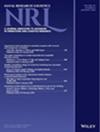Supply chain sustainability performance indicators - a content analysis based on published standards and guidelines
IF 2.1
4区 管理学
Q3 OPERATIONS RESEARCH & MANAGEMENT SCIENCE
引用次数: 47
Abstract
The goal of this paper is to provide researchers and practitioners with the required guidance to achieve a better assessment of the sustainability-related performance of an organization and its supply chain (SC). In order to achieve this, standards and guidelines covering three sustainability dimensions (economic, social, and environmental) were analyzed for the identification of sustainability performance indicators (SPIs). A content analysis approach was applied for the data collection and analysis. Twelve international standards and guidelines were identified and selected for the purpose of conducting an analysis to integrate the latest findings on SPIs in sustainable supply chain management (SSCM). The findings of the content analysis revealed 232 original set of instances of sustainability-related information, of which 46% were related to the environmental dimension, 43% were related to the social dimension and 11% were related to the economic dimension of sustainability. In order to provide a better understanding and evaluation, each sustainability dimension was characterized using attribute categories. A descriptive evaluation of the academic literature, standards, and guidelines resulted in 18 attribute categories. Collected indicators were classified according to these attribute categories. In-depth analysis, restructuring, standardizing of attribute categories and indicators have led to 70 unique and coherent SPIs. Out of which 49% indicators were identified as environmental SPIs, 37% as social SPIs and 14% as economic SPIs. The results revealed a complete lack of agreement among the current standards on how to measure the sustainability-related performance of an organization and its SC.供应链可持续性绩效指标-基于已发布的标准和指南的内容分析
本文的目的是为研究人员和实践者提供必要的指导,以更好地评估组织及其供应链的可持续性相关绩效。为了实现这一目标,我们分析了涵盖三个可持续性维度(经济、社会和环境)的标准和指南,以确定可持续性绩效指标(spi)。采用内容分析法进行数据收集和分析。确定并选择了12个国际标准和指南,目的是进行分析,以整合可持续供应链管理(SSCM)中spi的最新发现。内容分析的结果显示,232个原始的可持续发展相关信息实例集,其中46%与可持续发展的环境维度相关,43%与可持续发展的社会维度相关,11%与可持续发展的经济维度相关。为了提供更好的理解和评价,每个可持续性维度都使用属性类别进行表征。对学术文献、标准和指南进行描述性评估,得出18个属性类别。根据这些属性类别对收集到的指标进行分类。深入分析、重组、规范属性类别和指标,形成了70个独特而连贯的指标指标。其中49%的指标被确定为环境指标,37%的指标被确定为社会指标,14%的指标被确定为经济指标。结果显示,在如何衡量一个组织及其SC的可持续发展相关绩效的现行标准之间完全缺乏共识。
本文章由计算机程序翻译,如有差异,请以英文原文为准。
求助全文
约1分钟内获得全文
求助全文
来源期刊

Naval Research Logistics
管理科学-运筹学与管理科学
CiteScore
4.20
自引率
4.30%
发文量
47
审稿时长
8 months
期刊介绍:
Submissions that are most appropriate for NRL are papers addressing modeling and analysis of problems motivated by real-world applications; major methodological advances in operations research and applied statistics; and expository or survey pieces of lasting value. Areas represented include (but are not limited to) probability, statistics, simulation, optimization, game theory, quality, scheduling, reliability, maintenance, supply chain, decision analysis, and combat models. Special issues devoted to a single topic are published occasionally, and proposals for special issues are welcomed by the Editorial Board.
 求助内容:
求助内容: 应助结果提醒方式:
应助结果提醒方式:


